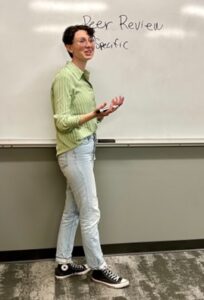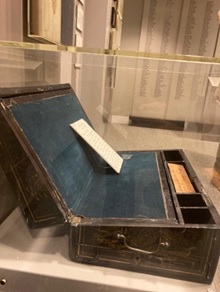This blog post was written by NCTE members Emily Powell and Joyce Kinkead.
In recent years, there has been a “turn” in writing studies, in which writing becomes the subject itself. Following on that theme, the material culture of writing is receiving increased attention. Laura R. Micciche, in an article in The Atlantic, looks at the traveling writing desk. Thomas Jefferson designed his own mobile writing desk, on which he drafted the Declaration of Independence. Joyce got to see one of these mobile writing desks at the Lowell National Historical Park (Massachusetts). Lucy Larcom (1824–1893), former “mill girl” turned writer and teacher, found a way to pen poetry and a childhood memoir on her compact desk, where quill, ink, paper, and pen knife could be stored.
Today’s students may also be tied to particular writing implements. We tend to think of Gen Z as digital natives, but Cydney Alexis found that students’ writing identities may be wrapped up in materials such as the Moleskine notebook. From teaching the history of writing, Joyce found that some students are wedded to particular writing instruments: one collected a couple thousand mechanical pencils, and another committed to a gel pen with the name InkJoy. In writing about their favorite writing tools, students talk about the sensory elements of the smooth strokes of a ballpoint pen, the clicking of a keyboard, or even the ding of a manual typewriter (popularized by Tom Hanks and Typewriter Rodeo poets). The romance of pen and paper still exists for some. More than one student in the History of Writing course has said to Joyce, “This is really interesting. Why didn’t we study this in high school?”
Emily plans to do just that when she returns to secondary-school teaching following graduate work, in which she has taken a class on the history of writing. She has gained respect for the material culture of writing and the possible implications for future assignments in her high school classroom. With laptops and smartphones, the physical act of writing is rarely even noticed. All we have to do is open a new text message, email, or document and begin typing. We don’t carry around wax tablets or make our own paper, but much can be learned by having students participate in hands-on activities related to the material culture of writing.
Making paper and writing on clay tablets has altered the way Emily looks at writing and sparked that educator portion of her brain: “How can I help future students have these same eye-opening experiences?” Emily helped teach her classmates how to make a quill pen. Joyce supplied the materials: feathers, penknives or box cutters, a bottle of ink, and paper sufficiently thick so the ink would not bleed through. Seeing how excited a roomful of graduate students were to create their own quill pens made us realize how powerful the lesson could be with secondary students.
Using a penknife (note the name of the instrument designed for just this purpose!), scrape the membrane covering the tip of the feather. The membrane is a cream-colored coating, and removing it will leave the tip opaque. With the quill arcing downward and the “belly” facing up, cut the tip off at an angle of about 45 degrees and a length of two centimeters. Some feathers might have something inside the quill called a quick, which will need to be removed. Simply use the pen knife to scrape it out. Make a second cut a centimeter from the tip following the direction of the first but shorter and at a blunter angle. Cut a slit into the center of the tip along the back side to allow the quill to hold ink. Now trim and sharpen the quill. Trimming the sides makes a fine point, resulting in thin lines, whereas trimming the tip to a chisel edge will make broader, more calligraphic lines. Dip the tip in ink and start writing! (Making the ink, too, will clue students in to even more history in the development of writing technologies.)
This is the way quills have been prepared since the 6th century, when feathers replaced reeds. Historically, swan feathers were used in Europe, while India employed flamboyant but plentiful peacock feathers. Left-wing feathers were preferred for right-handed writers. The capillary action of a quill pen anticipates the dip and nib pens of the early 19th century, which replaced them and did not have to be sharpened repeatedly.
In addition to cutting these pens, our class wrote our names in cuneiform on clay, using a popsicle stick or bamboo skewer to mimic a reed. We did the same with wax tablets and stylus. We finished by making paper, using a simple paper mill kit and a household blender. As we tried each of these DIY activities, we learned to be grateful for the ability to read and write with such ease. Modern conveniences such as easy access to paper, pens, and computers are astonishing when we know where the material culture of writing began. For secondary-level students, these hands-on lessons can be powerful since writing can be mundane and even frustrating for so many. English class doesn’t have to be a place students dread because of its association with essay writing. It can be exciting and interesting as we take time to teach students about the development of writing technologies through the ages and the impact of the material culture of writing on ourselves and our own lives.
 Emily Powell is a member of NCTE who is completing her master’s degree in
Emily Powell is a member of NCTE who is completing her master’s degree in English at Utah State University, where she took a course that included analysis of the development of writing technologies over a five-thousand-year history and got hands-on experience.
English at Utah State University, where she took a course that included analysis of the development of writing technologies over a five-thousand-year history and got hands-on experience.
Joyce Kinkead, Distinguished Professor of English, has been a member of NCTE for over 40 years and is the author of A Writing Studies Primer, among other books. Joyce can be found on Twitter and LinkedIn.
It is the policy of NCTE in all publications, including the Literacy & NCTE blog, to provide a forum for the open discussion of ideas concerning the content and the teaching of English and the language arts. Publicity accorded to any particular point of view does not imply endorsement by the Executive Committee, the Board of Directors, the staff, or the membership at large, except in announcements of policy, where such endorsement is clearly specified.

